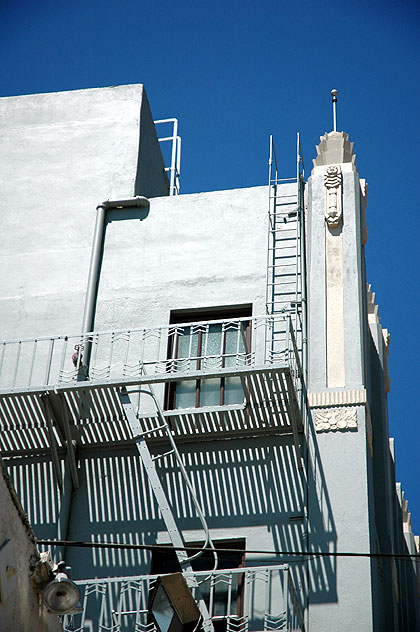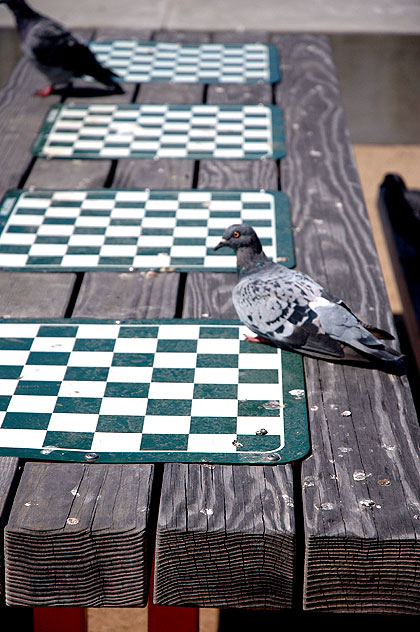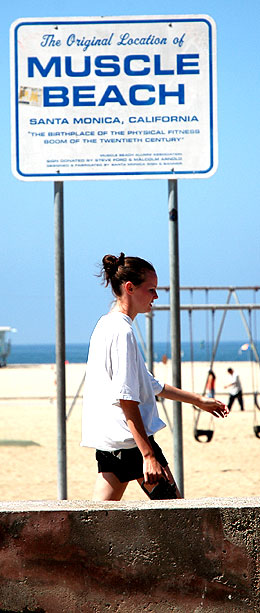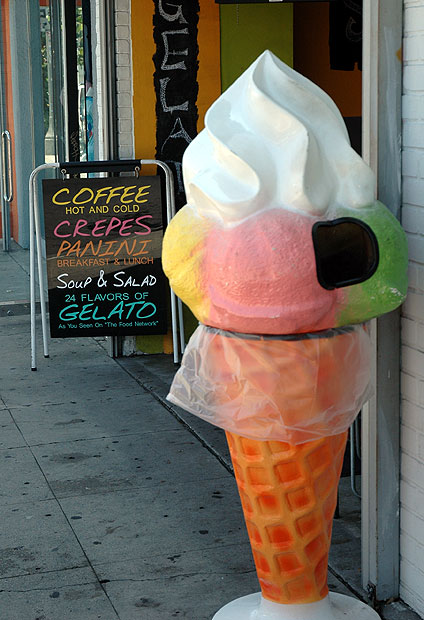It was long ago, in a time very different from today, yet it probably couldn't have happened anywhere but Santa Monica - "the zenith city by the sundown sea," as its boosters once called it, the beach town whose leaders have tried, intermittently, to ignore the beach, shut it down or dress it up, and, inevitably, failed, because the beach is the primary fact of Santa Monica.
"Remembering Muscle Beach" (Angel City Press, 1999) by Harold Zinkin with Bonnie Hearn recalls, in grand detail, one of the most glorious, significant and ultimately shameful chapters in Santa Monica's history.
Zinkin became the first Mr. California in 1941. In 1945, he won the national AAU weightlifting championship, light heavyweight division, and went on to invent the Universal Gym Machine. He was here, at Muscle Beach, at the center of it all, and his memory is as sharp as the extraordinary photographs which illustrate his story.
He begins the book with an apt quotation from Camus: "In the midst of winter, I finally learned that there was in me an invincible summer."
In the mid-1930s, when the country had been brought low by the Depression, a bunch of boys began gathering at The Beach, after school and work. Zinkin mopped the cafeteria floor at his school and later set pins in a bowling alley for 25 cents an hour. Then, he and his pals, drove 21 miles from east L.A. to The Beach.
"It began," Zinkin and Hearn write, "as a place where a few friends could work out in the sand and grew to include a mismatched but amiable group of athletes, circus performers, wrestlers, college gymnasts, movie stunt people.... On weekends the crowd of spectators could easily top ten thousand, all lining the sidewalk to watch amazing stunts."
Stuntmen and circus performers went to the beach to practice their craft. The "kids," boys and girls, went there for fun and stayed on to make lives, and livelihoods, out of it. Future stuntman Russ Saunders, future gym impresarios Vic Tanney and Joe Gold and Jack LaLanne (who used to drive all night from his Berkeley health club), along with Zinkin, were among the young athletes who became regulars at what Zinkin calls "the birthplace of the fitness movement,"
"Muscle Beach really was glue," he says. "You became part of it. You became part of the activities. There wasn't anywhere else in the world where you could find that kind of life or know people like these."
Legend credits a physical education teacher, Kate Giroux, with persuading the City of Santa Monica and the federal Works Progress Administration (WPA) to install a tumbling platform and other equipment on the beach. In fact, according to Zinkin, Paul Brewer and Jimmy Pfeiffer, who took gymnastics at John Adams Junior High, and Al Niederman, a former gymnast who worked as a mechanic for the bus company, built some basic equipment themselves and finally persuaded the City to kick in some money. As for Giroux, at one point, she tried to get the Muscle Beach habitués banned from the beach.
No one knows where the name came from, but some of the regulars, like Brewer, didn't like it, nor did they like to be labeled "Muscleheads," as they were, but they loved gymnastics and people loved watching them. Just south of the Santa Monica Pier, the Beach became more and more popular with athletes - including many young women - and spectators. In 1935, the City of Santa Monica hired UCLA coach Cecil Hollingsworth to teach gymnastics at Muscle Beach. By the late 1930s, there were 50 or 60 regulars and thousands of spectators came to see them perform on weekends.
Writers and photographers did countless stories and eventually The Beach was known nationally and internationally. To Zinkin and the other regulars, its fame was irrelevant, it was, he writes, "our education, our club, our cause. It was our youth."
When America went to war in 1941, Muscle Beach went with it.
The City of Santa Monica sent Zinkin, Saunders and Ran Hall out to promote the sale of war bonds. Subsequently, they and most of their pals served in the armed forces. One of then, John Kornoff, appeared on the cover of LOOK magazine, bare-chested, holding a rifle, as a symbol of the American fighting man. As much as anything else, Zinkin believes, that photo was "the beginning of a change of attitude regarding fitness," but, he adds, "It was certainly revolutionary to see a Muscle Beach regular glorified instead of vilified."
Joe Gold, served in the Coast Guard, and suffered spinal injuries that later made it necessary for him to use a wheelchair, but it didn't stop him from founding Gold's Gym and world Gym.
After the war, "No longer kids, the Muscle Beach regulars tried to find their places in the world that was ever so slowly starting to accept them... (and) show business was a natural next step."
Stars worked out with them. They worked as stunt doubles and one, Steve Reeves, became a star himself. As some of the regulars went off to work as chorus boys with Mae West, weight lifters and wrestlers began to join the gymnasts at The Beach.
In 1952, Zinkin opened a gym in Fresno. Within three years, he had five gyms and a TV exercise show, but he began to hear stories about trouble back at Muscle Beach.
The crowds of spectators had got too big for the City to deal with and it wanted to turn the space into parking lots. In addition, it was rumored that the owners of the Ocean Park Pier alleged that the free shows drew paying customers away from the Pier, while the owners of the Surf Rider Hotel found the entire scene offensive. In any event, the City closed Muscle Beach down after five weight lifters who lived in a boardwalk apartment were reportedly found partying with two underage girls. The headline in the Evening Outlook read: "Officials Stirred as Sex Orgy Bared." Although the cases against the weight lifters were dropped, the City bulldozed the area, claiming it had become a magnet for "perverts" and "narcissistic parasites." Several months later, the City reopened it, as "Beach Park 4." Use of the name "Muscle Beach" was forbidden, as were weightlifting and any events not approved by the City's recreation department.
It was never the same. Zinkin concludes, "Muscle Beach, as we knew it, may be gone, but the Muscle Beach attitude is not. Those of us who were around in the early days feel vindicated - happy to be alive and still flexing our muscles."









 Muscle Beach is an area in Venice on Ocean Front Walk two blocks north of Venice Boulevard - set up by the city as an outdoors weightlifting gym.
Muscle Beach is an area in Venice on Ocean Front Walk two blocks north of Venice Boulevard - set up by the city as an outdoors weightlifting gym. 



